ABSTRACT
Objective: Attention-deficit/hyperactivity disorder (ADHD) in adulthood presents unique challenges for primary care providers, and many lack confidence addressing it. To support them, a workgroup of volunteer primary care and mental health providers created an Adult ADHD Toolkit containing information about the disorder and treatment advice. The objective of this study was to establish the impact of implementing the toolkit in primary care.
Methods: Providers completed a survey immediately before and 5 months after the toolkit was implemented. Participation was voluntary and anonymous. Also, prescriptions for stimulant and nonstimulant adult ADHD medications were tracked 6 months before and 6 months after the toolkit was introduced.
Results: The response rate was 77.4% (n=24) at baseline and 64.5% (n=20) at follow-up. At follow-up compared to baseline, participants reported significantly higher comfort for assessment of adult ADHD (P=.039). Participants also reported higher comfort for nonmedication management (P=.10). There was no difference for comfort with medication management or prescribing practices pre versus post toolkit rollout, although participants were more comfortable with and prescribed a greater number of stimulants than nonstimulants.
Conclusions: Given the complexities of addressing adult ADHD, the results of this study are encouraging. Our findings highlight ways primary care providers can be supported, as well as areas that require greater attention. Still, more research is needed with a larger sample size to further explore and validate the efficacy of the toolkit.
Prim Care Companion CNS Disord 2021;23(1):20m02712
To cite: Mallo CJ, Powers S. Implementation of an adult ADHD toolkit in primary care: a prospective cohort survey. Prim Care Companion CNS Disord. 2021;23(1):20m02712.
To share: https://doi.org/10.4088/PCC.20m02712
aDepartment of Psychiatry, Maine Medical Center, Portland, Maine
*Corresponding author: C. Jason Mallo, DO, Department of Psychiatry, Maine Medical Center, 216 Vaughan St, Portland, ME 04102 ([email protected]).
In the past, providers did not have much incentive to learn about attention-deficit/hyperactivity disorder (ADHD) in adulthood, but the number of adult patients presenting for evaluation of ADHD is on the rise.1 Recent changes in social policies, diagnostic criteria, pharmaceutical marketing, and public awareness have contributed to this increase.2 Longitudinal studies3,4 demonstrate that 50% of childhood ADHD patients continue to have symptoms into adulthood, which coincides with established prevalence rates of ADHD in 5% of children and adolescents and 2.5% of adults.5 Symptoms of adult ADHD can be profound and include distractibility, disorganization, restlessness, and recklessness. Only 1 in 10 adults with ADHD receives treatment.6 Meanwhile, the cost of untreated adult ADHD is substantial on individual and societal levels7 and includes a 13-year reduction in life expectancy.8
Providers lack confidence addressing ADHD in adulthood. A 2012 survey of primary care providers (PCPs) showed 36% were not confident and only 8% very confident treating adult ADHD.9 Similarly, a 2009 survey10 indicated that 48% of PCPs were not confident at all in their diagnostic ability. The workup for patients complaining of adult ADHD is muddled by the need to rule out a complex differential, which often is limited to a patient’s self-report. Also, providers are apprehensive about malingering and prescribing controversial medications at risk of being misused.
Guidelines on diagnosis and treatment of ADHD in adulthood are lacking, and those that exist tend to emphasize treatment with stimulants at the expense of alternative options that also have a supportive evidence base. The largest psychiatric association in the world, the American Psychiatric Association, has practice guidelines11 for many common mental health disorders, but not for adult ADHD.
In response to these dilemmas, an Adult ADHD Toolkit (Table 1) was created between 2016 and 2019 by a workgroup of volunteer primary care and mental health providers at MaineHealth, the largest integrated health care system in Maine. The development of the toolkit has been described elsewhere.12 In short, the toolkit is intended for implementation in the primary care setting and is available to MaineHealth providers via the intranet. It includes a triage model for approaching patient complaints based on the complexity of a patient’s presentation, educational handouts for patients, and assessment and management strategies. The toolkit presents summary materials up front for quick access and more detailed information in the appendix. All materials in the toolkit are original and were generated based on a literature review and clinical consensus.
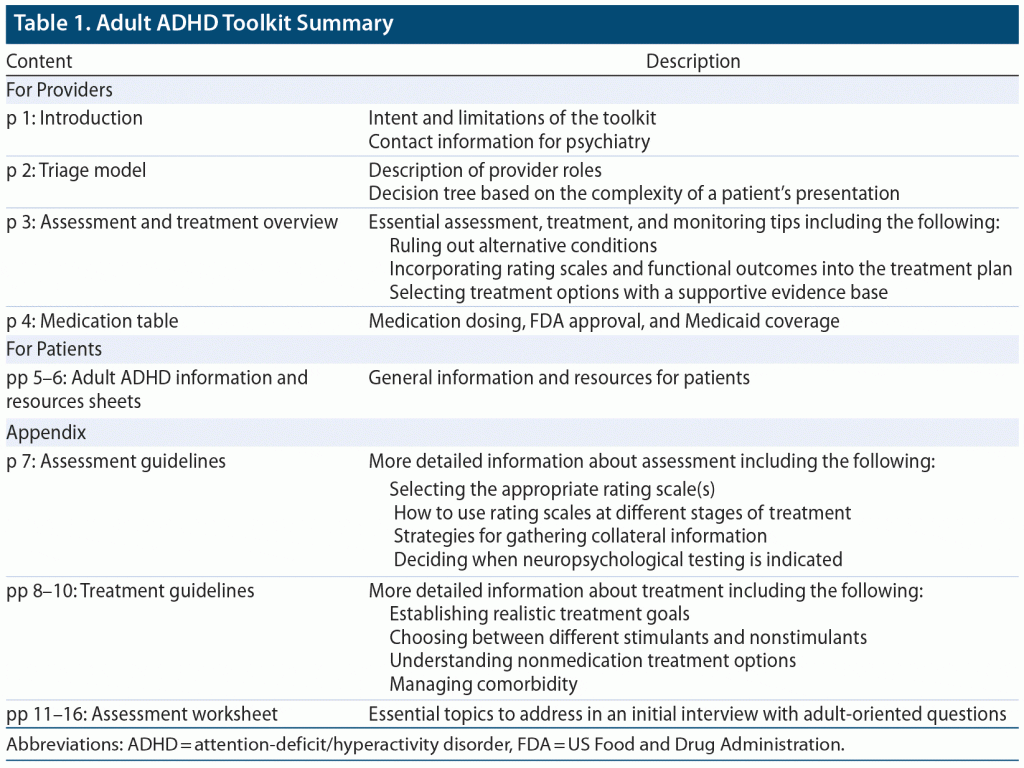
This prospective cohort study evaluated the utility of the Adult ADHD Toolkit in the primary care setting by investigating the impact on provider confidence in assessing and managing ADHD in adults after receiving the toolkit. We also examined how confident and skilled providers felt addressing different clinical domains of adult ADHD. Finally, we investigated whether stimulant and nonstimulant prescribing practices were affected by rolling out the toolkit.
METHODS
Overview
Our study used a prospective repeated-measure design to survey providers about their comfort and skill levels with adult ADHD immediately before and 5 months after the rollout of the Adult ADHD Toolkit in spring 2019. Participants included 22 internal medicine physicians, 2 advanced practice providers, and 7 behavioral health clinicians embedded in outpatient primary care offices at Maine Medical Center in Portland, Maine. We also tracked prescriptions of stimulant and nonstimulant medications used for adult ADHD by the sampled primary care providers before and after the rollout. The MaineHealth Institutional Review Board exempted this study from review given that it did not directly involve patients or their personal identifiers and participation of providers was voluntary and anonymous.
Survey Design
The survey was adapted from the ADHD Questionnaire for Primary Care Providers (AQ-PCP) with permission of the developers and the Children’s Hospital of Philadelphia.13 The AQ-PCP was designed for pediatric providers; therefore, adaptations in the current version focused on implementation of language appropriate for adult patients. Additional questions specific to the content of the Adult ADHD Toolkit were also incorporated. The survey included demographic questions about provider role, years since completing training, and average number of patients seen with adult ADHD. The majority of survey questions asked participants to rate their comfort and skill with various topics related to adult ADHD using a 4-point Likert scale: “not at all,” “usually,” “somewhat,” and “very much.”
Survey Implementation
We attended provider in-service meetings at baseline and 5-month follow-up and distributed printed surveys to participants at the beginning of the meetings. Next, we handed out printed copies of the Adult ADHD Toolkit and oriented participants to accessing the toolkit online. We also did a presentation focused on introducing the toolkit at the baseline meeting and on diagnostic and treatment tips from the toolkit at follow-up. Each presentation lasted approximately 20 minutes and included time for participant questions.
Data Analysis
All results were entered into a database for analysis. Survey questions were grouped into 3 scales based on content: assessment, nonmedication management, and medication management. We performed a factor analysis, which supported the scales used and exactly recreated the assessment scale. To facilitate a quantitative analysis, we assigned numeric values to the Likert scale categories as follows: not at all=1, usually=2, somewhat=3, and very much=4. The responses within a scale were summed to create individual scores that were treated as continuous. We calculated the mean and standard deviation for each score and used t tests to examine differences between the scores before and after the toolkit rollout. The significance level was set at .05. To compare more specific survey responses, we used descriptive statistics shown as frequency (n, %). Responses of behavioral health clinicians were excluded from analyses of questions about medication management given they were nonprescribers.
Prescription Data
The number of prescriptions for ADHD medications per total patient panel was tracked monthly, 6 months before and after the introduction of the toolkit. Aggregate prescription data for primary care providers included in the study were gathered from the electronic medical record and included all medications identified by providers as being prescribed for ADHD in adulthood. Prescriptions were categorized as either stimulant or nonstimulant. Stimulants included all amphetamine- and methylphenidate-based prescriptions, and nonstimulants included clonidine, guanfacine, bupropion, atomoxetine, and desipramine. We used t tests with a .05 significance level to compare the proportion of stimulant and nonstimulant medications prescribed before and after the toolkit rollout.
RESULTS
Participants
Of the 31 providers surveyed, 77.4% (n=24) completed the survey at baseline and 64.5% (n=20) at 5-month follow-up. Participants were similar at baseline and follow-up in regard to provider role, years since completing training, and average number of patients with adult ADHD seen weekly (Table 2). Most participants were physicians (70.5%), followed by behavioral health clinicians (22.7%) and advanced practice providers (6.8%). For years since completing training, the most common selection was 6–10 years (34.1%) and the least common was 0–5 years (13.6%). The average number of adult patients with ADHD seen per week ranged from 0 to 6, with 2.3% seeing 0, 63.6% seeing 1–3, and 34.1% seeing 4–6.
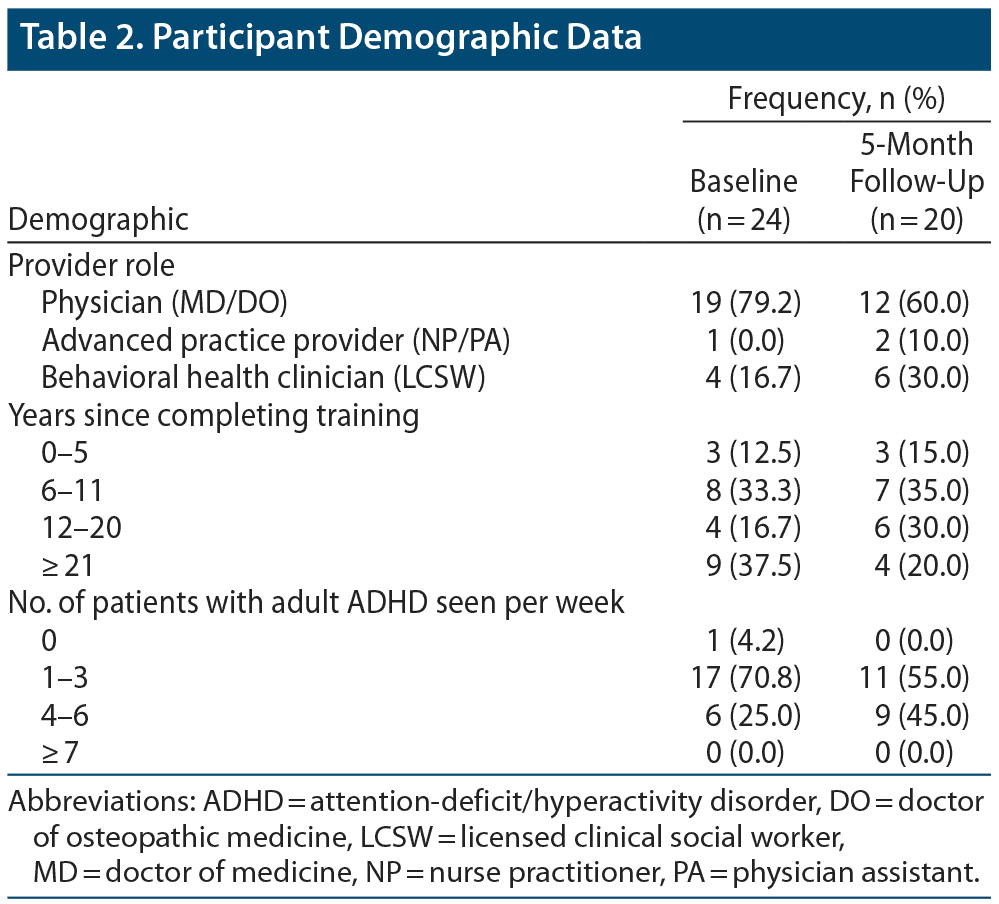
Assessment
For survey questions in the assessment scale, comfort level significantly increased from baseline (12.7±5.0) to 5-month follow-up (16.1±5.3, P=.039, Figure 1A). The majority of participants selected lower comfort level ratings (“not at all” or “somewhat”) at baseline and higher comfort level ratings (“usually” or “very much”) at follow-up for all questions in this scale (Table 3). For instance, at baseline most participants selected “not at all” for questions pertaining to adult ADHD rating scales, whereas at follow-up most selected “usually.” The most common selection for obtaining collateral information at baseline was “somewhat” and at follow-up was “usually.”
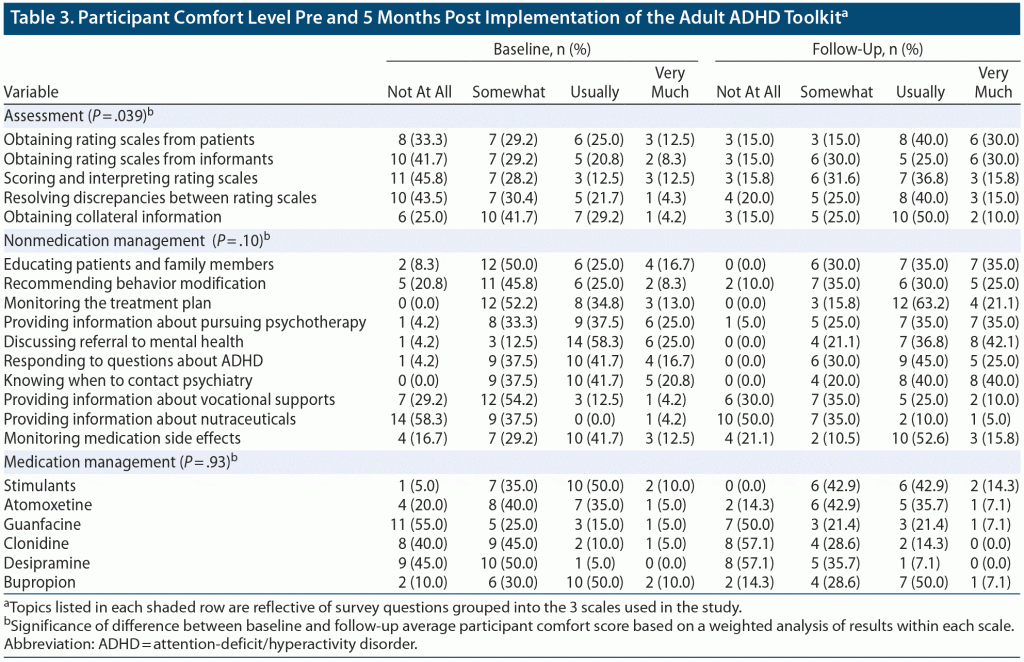
As comfort level with questions pertaining to assessment increased, so did self-reported skill. Participants reported greater skill level with initial assessment of adult ADHD at follow-up relative to baseline. At follow-up, 63.2% of participants selected higher-level ratings for skill with initial assessment versus 36.2% at baseline.
Management
Participant comfort level did not change significantly pre versus post toolkit rollout for questions in the management scales (Figure 1A). However, a higher comfort level was seen at follow-up for questions in the nonmedication management scales (24.5±5.6 vs 27.5±5.9, P=.10). This increase stood out for comfort with educating patients and families about adult ADHD and recommending behavioral management strategies (Table 3). For both questions, most participants selected “somewhat” at baseline and “usually” or “always” at follow-up. For many nonmedication management questions, at baseline and follow-up “usually” was a common selection. However, at baseline and follow-up most selected “somewhat” for providing information about obtaining vocational supports and “not at all” for providing information about nutraceuticals.
Comfort level was similar at baseline (12.6±3.4) and follow-up (12.5±3.6) for questions in the medication management scale (P=.93). Participants were more comfortable providing recommendations for stimulants compared to nonstimulants (Table 3). Only 5% reported being “not at all” comfortable with stimulants at baseline and 0% at follow-up. The majority of participants selected higher comfort level ratings for stimulants at baseline and follow-up, whereas for nonstimulants the majority selected lower comfort level ratings. An exception for nonstimulants was bupropion, for which participants mostly selected “usually” or “always” being comfortable with.
Perceived skill increased along with comfort level for questions about nonmedication and medication management options. For skill with incorporating functional outcomes into the treatment plan, 47.4% reported higher-level ratings at follow-up compared to 25% at baseline.
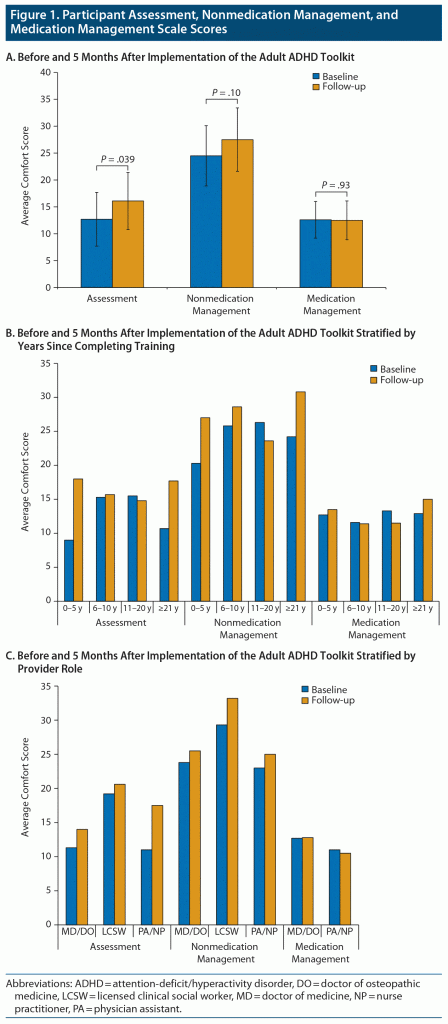
Other Factors
Compared to other groups, participants with 0–5 years since completing training had greater changes from baseline to follow-up for the assessment and nonmedication management scales (Figure 1B). Additionally, the majority of participants in this group had higher skill level ratings at follow-up than baseline for initial assessment (66.7% vs 0%, respectively), educating patients and families (66.6% vs 0%), and requesting psychiatric consultation (100% vs 0%). Participants with ≥21 years since completing training also had higher levels at follow-up than baseline for the assessment and nonmedication management scales, while results did not change as much for those in the intermediate groups.
Participants who reported seeing more patients on average per week had higher comfort level ratings for the assessment, medication management, and nonmedication management scales at baseline and follow-up. Behavioral health clinicians had higher comfort level ratings than physicians and advanced practice providers at baseline and follow-up for questions in the assessment and nonmedication management scales (Figure 1C).
Prescribing Practices
The number of stimulant and nonstimulant prescriptions per patient panel did not change significantly after the toolkit rollout (Figure 2). The proportion of stimulant prescriptions per 1,000 patients 6 months before the rollout was 15.11 and 6 months after was 16.13 (P=.10). The proportion of nonstimulants prescribed before and after the rollout was 7.88 and 7.22 (P=.06). Stimulants were prescribed approximately twice as much as nonstimulants throughout the year.
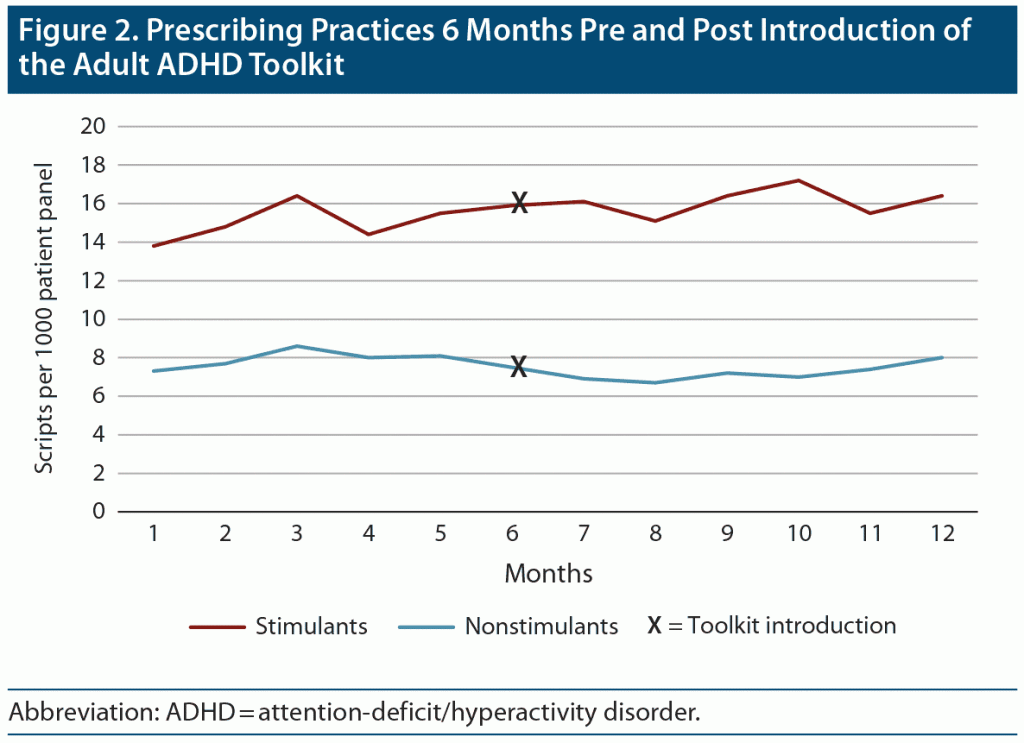
DISCUSSION
The results of our study offer important insights into how primary care providers can be supported in assessing and managing adult ADHD with a toolkit. After implementation of our toolkit, primary care providers reported significantly increased comfort with assessment of adult ADHD, in addition to higher comfort ratings with nonmedication management. The toolkit had less of an impact on prescribing practices and comfort with medication management; however, our results shed light on how providers can be bolstered in this area.
This is the first study, to our knowledge, evaluating the use of a toolkit for ADHD in adulthood. Other toolkits for mental health disorders exist and serve as valuable resources for providers. Research has been done on toolkits in primary care for depression,14–16 suicide prevention,17 autism,18 and pediatric ADHD.13 In these studies,13–18 the toolkits were universally well received, and providers reported their clinical practice was positively impacted.
Compared to other surveys done in primary care, the degree of survey participation in our study was relatively high.19 Participants were mostly physicians with varied years of practice and spanned roles commonly seen in primary care settings. They were active in patient care, regularly seeing patients with adult ADHD.
There are various materials in the toolkit that most likely contributed to providers feeling more comfortable and skilled with assessment of adult ADHD. For instance, the toolkit offers providers direction about how to use validated rating scales and what conditions to rule out before diagnosing ADHD in adulthood. There is also an assessment worksheet with adult-oriented questions to guide providers through an initial evaluation.
Comfort with management may naturally follow comfort with assessment but requires a greater amount of time than our study allowed. Additionally, our study may have been underpowered to show a true difference for comfort with nonmedication management pre versus post toolkit rollout. While the increase in comfort level for questions in the nonmedication management scales was not statistically significant, the increase is nonetheless encouraging. The toolkit includes information about patient education, psychotherapy, vocational counseling, exercise, diet, and nutraceuticals. The toolkit also emphasizes incorporating functional outcomes into the treatment plan, and perceived skill in this area increased after the toolkit was implemented. Provider responses at both baseline and follow-up revealed weaknesses in comfort with vocational counseling and nutraceuticals. More provider education about these topics is therefore indicated.
On the basis of our results, further provider education about nonstimulant medications is needed. Interestingly, PCPs are more likely to take an active role in diagnosing and treating adult ADHD if they are aware of effective nonstimulant medication options.10 Providers in our study were more comfortable with stimulants than nonstimulants, which is not surprising. Stimulants have been prescribed since the late 1930s, while nonstimulants were introduced less than 20 years ago and many are used off-label.20 Nonstimulants can treat comorbid symptoms of anxiety and depression, and compared to stimulants, they lack the same risk of misuse and diversion, have smoother and longer-lasting effects, and are less associated with agitation, difficulty sleeping, and appetite suppression.21–23
The toolkit seems particularly useful for providers practicing 0–5 years and those with ≥21 years since completing training. Our findings could indicate differences in generational attitudes about ADHD in adulthood as well as variation in clinical flexibility over the course of a provider’s career. Midcareer providers may be less likely to benefit from the toolkit due to education they received deemphasizing ADHD as a condition that can exist in adulthood. Also, they may be less likely to implement new approaches at a time when they have just honed their practice. Other explanations are possible, and future research that ascertains what underlies our findings could help direct educational efforts for providers at various points in their career.
Behavioral health clinicians may be a vital resource for addressing adult ADHD given they had higher comfort ratings than other provider types. It has been established that integrating behavioral health clinicians in primary care settings helps PCPs feel more confident treating common mental health disorders, increases the use of behavioral interventions by PCPs, and improves patient satisfaction.24 For patients complaining of adult ADHD symptoms, behavioral health clinicians can administer rating scales, evaluate them for different mental health disorders, obtain collateral information, and manage the treatment plan. Behavioral health clinicians can also help patients establish lifestyle changes, learn and incorporate organizational tactics, and reframe negative cognitive distortions.
While there were no significant changes, statistically or clinically, for prescribing practices associated with the toolkit, the increasing prevalence of stimulant misuse in the United States remains a concern.25 The idea that greater comfort level with assessment could be correlated with more diagnostically appropriate prescribing practices is hopeful. However, this study did not examine this link, and the public health risk associated with prescribing stimulants needs to be carefully balanced with potential patient benefits. The Adult ADHD Toolkit includes recommendations for safe prescribing practices and underscores the danger when stimulants are contraindicated.
There were a number of limitations in our study, including a small sample size. Instead of tracking changes in individual responses over time, we sampled from the same group of providers before and after the toolkit was introduced and examined changes across the groups. However, the groups appeared similar based on demographic data, and the high response rates obtained at baseline and follow-up support that they were alike. Another limitation of our study is the possibility that participants may have provided positive answers to not offend or lead to negative feedback. However, responses were varied among survey questions. Moreover, the authors attempted to limit this bias by gathering participant responses voluntarily and anonymously, as well as using an established survey designed for use in primary care.
Future studies could expand on our findings by examining the impact of the toolkit on providers with different training backgrounds. For example, we surveyed internists, and it would be useful to know whether physicians trained in family medicine, who have greater experience working with younger patients, respond similarly. Our survey measured perceptions of change, not actual learning. Future efforts may examine the accuracy of adult ADHD diagnosis and more directly test provider knowledge of adult ADHD assessment and management. Additionally, it would be helpful to explore the extent to which providers use the toolkit and how that impacts clinical practice.
CONCLUSION
Responding to patient complaints about adult ADHD in a busy primary care practice is not an easy task. The Adult ADHD Toolkit was developed to help providers in primary care settings navigate the complexities of this disorder. Our study examined the impact of the toolkit on perceived comfort and skill and found providers benefited in many domains integral to the management of adult ADHD. Results indicated that providers would benefit from greater education about nonstimulant treatment options. Broader implications for implementing toolkits for mental health disorders in primary care may be drawn from our results. For example, providers either at the beginning or late in their careers may especially benefit from toolkits, and behavioral health clinicians are likely a valuable resource for implementing them.
Submitted: June 8, 2020; accepted September 3, 2020.
Published online: February 18, 2021.
Potential conflicts of interest: None.
Funding/support: None.
CLINICAL POINTS
- ADHD in adulthood is a growing concern among patients seen in primary care.
- Toolkits help providers address patient complaints about ADHD and increase provider confidence.
- Providers can benefit from learning more about nonstimulant ADHD treatment options.
References (25)

- Montejano L, Sasané R, Hodgkins P, et al. Adult ADHD: prevalence of diagnosis in a US population with employer health insurance. Curr Med Res Opin. 2011;27(suppl 2):5–11. PubMed CrossRef NLM
- Hinshaw P, Scheffler M. The ADHD Explosion: Myths, Medication, Money, and Today’s Push for Performance. New York, NY: Oxford University Press; 2014.
- Faraone S, Biederman J, Mick E. The age-dependent decline of ADHD: a meta-analysis of follow-up studies. Psychol Med. 2006;36(2):159–165. PubMed CrossRef NLM
- Kessler R, Adler L, Barkley R, et al. Patterns and predictors of ADHD persistence into adulthood: results from the National Comorbidity Study Replication. Biol Psychiatry. 2005;57:1442–1451. PubMed CrossRef NLM
- American Psychiatric Association. Diagnostic and Statistical Manual of Mental Disorders. Fifth Edition. Washington, DC: American Psychiatric Association; 2013.
- Kessler RC, Adler L, Barkley R, et al. The prevalence and correlates of adult ADHD in the United States: results from the National Comorbidity Survey Replication. Am J Psychiatry. 2006;163(4):716–723. PubMed CrossRef NLM
- Secnik K, Swensen A, Lage M. Comorbidities and costs of adult patients diagnosed with ADHD. Pharmacoeconomics. 2005;23(1):93–102. PubMed CrossRef NLM
- Barkley RA, Fischer M. Hyperactive child syndrome and estimated life expectancy at young adult follow-up: the role of ADHD persistence and other potential predictors. J Atten Disord. 2019;23(9):907–923. PubMed CrossRef NLM
- Goodman DW, Surman CB, Scherer PB, et al. Assessment of physician practices in adult attention-deficit/hyperactivity disorder. Prim Care Companion CNS Disord. 2012;14(4):PCC.11m01312. PubMed NLM
- Adler L, Shaw D, Sitt D, et al. Issues in the diagnosis and treatment of adult ADHD by primary care physicians. Prim Psychiatry. 2009;16(5):57–63.
- Practice Guidelines. American Psychiatric Association. Accessed June 1, 2020. https://psychiatryonline.org/guidelines
- Mallo C. Introducing an adult ADHD toolkit for application in collaborative care. JMMC. 2020;2(1):1–6.
- Power T, Mautone J, Manz P, et al. Managing ADHD in primary care: a systematic analysis of roles and challenges. Pediatrics. 2008;121(1):65–72. PubMed CrossRef NLM
- Brody DS, Dietrich AJ, deGruy F 3rd, et al. The depression in primary care tool kit. Int J Psychiatry Med. 2000;30(2):99–110. PubMed CrossRef NLM
- Byatt N, Biebel K, Moore Simas TA, et al. Improving perinatal depression care: the Massachusetts Child Psychiatry Access Project for Moms. Gen Hosp Psychiatry. 2016;40(C):12–17. PubMed CrossRef NLM
- Libby JM, Stuart-Shor E, Patankar A. The implementation of a clinical toolkit and adolescent depression screening program in primary care. Clin Pediatr (Phila). 2014;53(14):1336–1344. PubMed CrossRef NLM
- McFaul M, Mohatt N, DeHay T. Development, evaluation, and refinement of the suicide prevention toolkit for rural primary care practices. J Rural Ment Health. 2014;38(2):116–127. CrossRef
- Nicolaidis C, Raymaker D, McDonald K, et al. The development and evaluation of an online healthcare toolkit for autistic adults and their primary care providers. J Gen Intern Med. 2016;31(10):1180–1189. PubMed CrossRef NLM
- Kellerman SE, Herold J. Physician response to surveys: a review of the literature. Am J Prev Med. 2001;20(1):61–67. PubMed CrossRef NLM
- Lange KW, Reichl S, Lange KM, et al. The history of attention-deficit/hyperactivity disorder. Atten Defic Hyperact Disord. 2010;2(4):241–255. PubMed CrossRef NLM
- McGough JJ. Treatment controversies in adult ADHD. Am J Psychiatry. 2016;173(10):960–966. PubMed CrossRef NLM
- Wilens TE, Morrison NR, Prince J. An update on the pharmacotherapy of attention-deficit/hyperactivity disorder in adults. Expert Rev Neurother. 2011;11(10):1443–1465. PubMed CrossRef NLM
- Kolar D, Keller A, Golfinopoulos M, et al. Treatment of adults with attention-deficit/hyperactivity disorder. Neuropsychiatr Dis Treat. 2008;4(2):389–403. PubMed NLM
- Robinson P, Reiter J. Behavioral Consultation and Primary Care: a Guide to Integrating Services. 2nd ed. Switzerland: Springer International Publishing; 2016.
- The DAWN report: emergency department visiting involving attention-deficit/hyperactivity disorder stimulant medications. Substance Abuse and Mental Health Services Administration. SAMHSA. Published January 24, 2013. Accessed April 11, 2020. https://www.samhsa.gov/data/sites/default/files/DAWN073/DAWN073/sr073-ADD-ADHDmedications.pdf
This PDF is free for all visitors!




